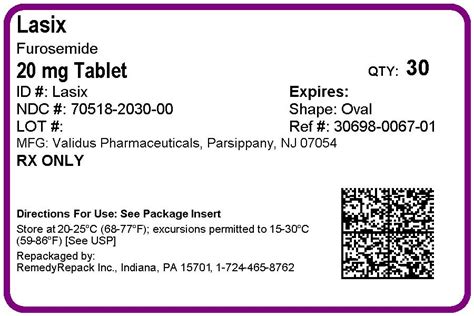Intro
Discover what Lasix is, a loop diuretic used to treat edema, fluid retention, and high blood pressure, working by increasing urine production, and learn about its uses, side effects, and interactions, including furosemide mechanisms and alternatives.
The topic of Lasix, also known as furosemide, is a crucial one in the medical field, particularly for individuals dealing with fluid retention and swelling. This condition can be caused by a variety of factors, including heart failure, liver disease, and kidney disorder. Understanding Lasix and its role in treating these conditions is vital for effective management and relief. Lasix is a loop diuretic that works by increasing urine production, helping the body get rid of excess fluid. This medication is prescribed by doctors to patients who are experiencing edema, which is the medical term for swelling caused by fluid retention.
The importance of Lasix cannot be overstated, as it provides significant relief to individuals suffering from the discomfort and health risks associated with fluid buildup. By facilitating the removal of excess fluid, Lasix helps in reducing swelling, thereby improving the quality of life for patients. Moreover, the medication plays a critical role in managing conditions like hypertension and nephrotic syndrome, where controlling fluid levels is essential. The mechanism of action of Lasix involves inhibiting the sodium-potassium-chloride cotransporter in the thick ascending limb of the loop of Henle, leading to increased urine production and subsequent reduction in fluid volume.
Lasix is widely used due to its effectiveness and relatively quick action. It is available in various forms, including tablets and injections, making it accessible for different patient needs. However, like all medications, Lasix must be used under medical supervision to avoid potential side effects and ensure it is used safely and effectively. The dosage and administration of Lasix depend on the patient's condition, age, and response to treatment, highlighting the need for personalized medical care. As with any diuretic, patients on Lasix need to be monitored for signs of dehydration and electrolyte imbalance, which can be managed through appropriate medical guidance and follow-up care.
How Lasix Works

Benefits of Lasix
The benefits of Lasix are numerous and significant for patients dealing with fluid retention. Some of the key advantages include: - Rapid relief from edema and associated discomfort - Effective management of hypertension - Reduction in the risk of complications from fluid overload - Improvement in cardiac function for patients with heart failure - Enhanced quality of life through reduction in swelling and discomfort These benefits underscore the importance of Lasix in clinical practice, especially when used appropriately and under medical guidance.Side Effects and Precautions

Contraindications and Warnings
Lasix is contraindicated in patients with known hypersensitivity to furosemide or sulfa drugs. It should be used with caution in patients with hepatic cirrhosis, renal impairment, and in pregnant women, especially during the first trimester. Additionally, patients should be warned about the potential for ototoxicity, especially with high doses or rapid administration. The medication's effect on electrolyte balance necessitates regular monitoring of potassium, sodium, and chloride levels to prevent imbalance.Dosage and Administration

Interactions with Other Medications
Lasix can interact with various medications, altering their effects or increasing the risk of side effects. Notable interactions include: - Potassium supplements and potassium-sparing diuretics, which can increase the risk of hyperkalemia - Lithium, as Lasix can increase lithium levels - Digoxin, where Lasix can increase the risk of digitalis toxicity - Corticosteroids, which can increase the risk of hypokalemia Understanding these interactions is crucial for safe and effective management of patients on Lasix.Long-Term Use and Monitoring

Patient Education
Educating patients on the proper use of Lasix, its potential side effects, and the importance of adherence to the prescribed regimen is vital. Patients should be informed about the signs of dehydration, the need for regular follow-up appointments, and how to manage common side effects. Empowering patients with knowledge enables them to take an active role in their healthcare, enhancing the effectiveness of Lasix therapy.Alternatives and Future Directions

Conclusion and Future Perspectives
In conclusion, Lasix remains a cornerstone in the management of fluid retention and associated conditions. Its efficacy, rapid onset of action, and wide range of applications make it a valuable medication in clinical practice. However, its use requires careful consideration of potential side effects, interactions, and the need for ongoing monitoring. As medical science advances, the development of new therapies and the refinement of existing ones will continue to improve patient outcomes. The role of Lasix in this evolving landscape will likely remain significant, given its established benefits and the ongoing need for effective diuretic therapy.What is Lasix used for?
+Lasix, also known as furosemide, is used to treat fluid retention (edema) in people with congestive heart failure, liver disease, or a kidney disorder.
How does Lasix work?
+Lasix works by increasing urine production, helping the body get rid of excess fluid. It acts on the kidneys to increase urine output by inhibiting the reabsorption of sodium, chloride, and potassium.
What are the common side effects of Lasix?
+Common side effects of Lasix include dizziness, lightheadedness, and increased urination. More serious side effects can include dehydration, electrolyte imbalance, and in rare cases, hearing loss.
We invite you to share your thoughts and experiences with Lasix in the comments below. If you found this article informative, please consider sharing it with others who might benefit from understanding the role and use of Lasix in managing fluid retention and associated conditions. Your engagement and feedback are invaluable in creating a community that supports and educates each other on important health topics.
